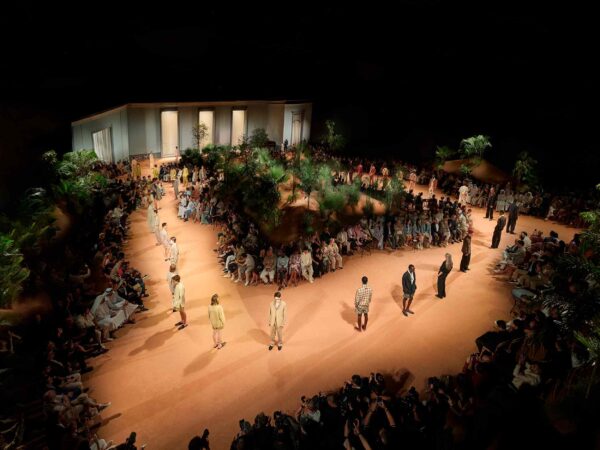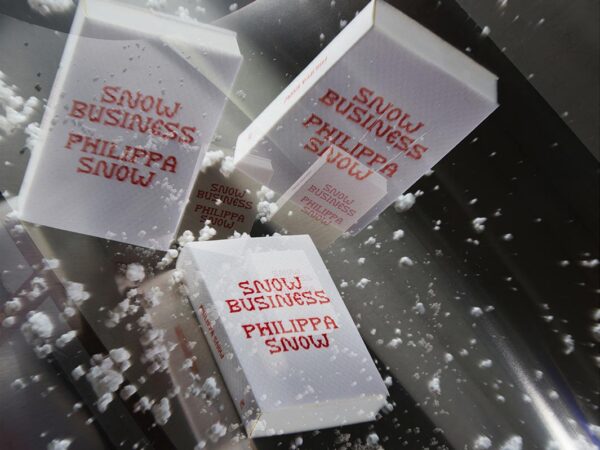
During Couture Week Spring 2025, fashion critic Katharine K. Zarrella reconsiders the role of the time-honored craft as ready-to-wear prices skyrocket
“Is it so much to ask for one designer to make a dress I can actually wear?” This query was posed outside of Alessandro Michele’s fantastical Valentino Spring 2025 Haute Couture debut by an actual haute couture client—one of the lucky few who can afford to spend hundreds of thousands of dollars for a hand-crafted, custom-fit garment by a brand certified in the time-honored craft. For those unfamiliar, these brands include the likes of Christian Dior, Armani Privé, Chanel, and yes, Valentino.
If you were in her position, you might have asked the same question. Michele’s first couture runway spectacle—and believe you me, it was a spectacle—was fit for an old-world Italian contessa who exists exclusively inside a Fellini film. It opened with a harlequin-check gown so wide and full that it consumed the entire stage at Paris’s Palais Brongniart, where the designer’s debut collection for the house was shown. Later, he re-interpreted signature Valentino codes—high lace necks, that unmistakable shade of red—through the lens of the outsize fantasy his fans have come to adore. Many models wore masks, and across the black wall flashed the innumerable inspirations that flew through Michele’s mind while designing via neon lights—Othello, Rooster, and Theory of Signs among them (these were all printed out for guests in a 200-some-odd-page manifesto that greeted us guests upon arrival to our seats). It was theater—mildly evocative of Oh, Mary! or the 1968 on-screen adaptation of Romeo and Juliette. But that’s what Michele’s all about, and likely why he was hired by Valentino. So his collection, and that client’s lament, raise the question that I and so many other journalists and fashion obsessives have been asking since I started attending the couture shows a decade ago: What is the point of this stuff? Is it pure art, a dream that informs what we’ll see on the ready-to-wear runways in a month? Does it need to sell? And if yes, to whom?
What I’ve come to learn is that it would be asinine to ascribe one purpose to all haute couture. That would be like assigning one purpose to all music, food, or art—sometimes the latter is for business, sometimes it’s for pleasure. Occasionally it’s both, which can make things awkward at passport control.
The point is that Michele is an unapologetic dreamer—that’s why so many love him. He’s able to dream in a world where most of us simply sleep. While some of those gowns might end up on celebrities at the Oscars (if I were a betting woman, my money would be on the Wicked duo) they’ll probably just live in museums and in our dreams, should we be so lucky. Even so, they’ll make us want to buy the Valentino shoes we’ll see at his ready-to-wear show next month, because we want a little hit of that intoxicating escapism.
In the notes for the Armani Privé’s 20th anniversary show, Giorgio Armani stated, “Haute couture is when fashion becomes art.” So often, the term “art” in show notes is shorthand for “experimental”, “over-the-top”, and/or “unwearable.” Not so in Mr. Armani’s case. Indeed, his celebratory outing—with its exuberance of painstakingly applied crystals, turbans that looked to be spun from diamante spiders’ webs, and silk jacket-trouser combos that recalled watercolor paintings of vibrant pink blooms—erred more on the side of fine art than pure fashion, and not just because of their inevitably haute price tags. However, they were among the most wearable garments of the week, and among the garments showgoers wanted to wear most. One diamond-dappled client sitting across from me in Mr. Armani’s splendidly intimate Paris palazzo runway show was physically restrained by her male companion as a sequined, royal-blue jacket-and-trousers pairing strode by. That earlier-mentioned client would have no trouble finding a dress to wear here. In fact, Mr. Armani proposed enough opulent, ebullient gowns and crystal slips in soignée silhouettes to dress the entire upcoming Oscars red carpet. And I’d be surprised if those diamond-doused clients in the front row hesitated to purchase their favorite pieces.
This season’s haute couture collections were as much an escape into fantasy as they were a stroll through fashion history—fitting, considering the shows kicked off just after The Louvre bowed “Louvre Couture: Art and Fashion Statement Pieces,” a sprawling exhibition that juxtaposes key fashion designs from the 1960s through present day with items from the museum’s decorative arts collection. There, works by Cristòbal Balenciaga, Demna, Hubert de Givenchy, Karl Lagerfeld, Daniel Roseberry for Schiaparelli, Jonathan Anderson (yes, the pigeon bag is in there) and more sit alongside artwork and decor from the Middle Ages, Grand Siècle, and beyond. The show, curated by Olivier Gabet, is on through July 21, should you find yourself in Paris.
Like Michele at Valentino and the Louvre, Dior’s Maria Grazia Chiuri found herself exploring “the creativity of previous centuries,” according to the show notes. She looked to Yves Saint Laurent’s 1958 Trapèze collection for the house, as well as Mssr. Christian Dior’s sculptural 1952 insect-like Cigale silhouette, but she presented this respectful nod to the Dior archive through a lens of whimsy, fairy dust, and wonder, offering sheer crinoline gowns dripping in flowers, Victorian-looking white lace, and a gauzy skirt draped to resemble a rose. She considered Lewis Carroll’s Alice in Wonderland while designing this season and considered how haute couture could transport us into another reality—a garden of otherworldly delights where extruding cage skirts constitute sensible, wearable, everyday fare.
At Schiaparelli, Daniel Roseberry, too, trotted down memory lane. While designing his collection, which was inspired by the myth of Icarus, he studied the signatures of past masters he admires including Azzedine Alaïa, Paul Poiret, Charles Fredrick Worth, and, of course, Elsa Schiaparelli. Perhaps more than any other designer showing couture, he digested the wisdom of his predecessors, advanced their techniques and essences and catapulted them into the 21st century. For instance, he and the Schiap atelier deployed turn-of-the-century (last century, not this one) couture techniques to craft thoroughly futuristic designs, like a gown with a structured split basque bodice and a tulle skirt that seemingly floated in mid-air. Backstage, Roseberry noted that he hoped to give those couture techniques a “modern spirit” and create something that feels “revelatory.” He accomplished that and then some. These pieces—highly structured, snugly restrictive, certainly cumbersome (but in a satisfying sort of way)—will undoubtedly turn up on red carpets. (If they don’t, some stylists aren’t doing their jobs very well.) It’s not your typical couture, the type one might wear to lunch in Dubai or to board a private jet at Teterboro or even to attend a charity gala, unless you’re deliciously daring, like Jordan Roth. But Elsa wasn’t a typical designer. Women of unfathomable means and imagination will find plenty of treasures here. The rest of us can enjoy being seduced by Roseberry’s sartorial surrealism.
Chanel, meanwhile, welcomed guests into the Grand Palais, where it installed a Guggenheim Museum-esque spiral, up which its tweed-clad models marched. This outing, designed by the in-house team, spun a cotton-candy-hued effervescence—a lightness that recalled the wink and nod the late Karl Lagerfeld embraced during his tenure at the historic maison. Wearable? Absolutely—suits galore! Plus plenty of easy, but beautifully made frocks for those in the market. And there was the requisite drama, thanks to a billowing violet satin opera coat that devoured everything in its path. In a sense, this sherbety lineup served as the first of several amuse bouches, which will (ideally) cleanse the fashion set’s palates ahead of Mathieu Blazy’s anticipated debut as the brand’s creative director in October.
But back to our main storyline: history, fantasy, wearability. Leave it to Viktor & Rolf’s Viktor Horsting and Rolf Snoeren—those Dutch fashion daredevils—to turn the entire season on its head. For spring, this enigmatically irreverent duo broke the space-time continuum, effectively de-technologizing artificial intelligence to create their spring couture collection, which was profoundly repetitive but also, somehow, remarkably varied. “We were our own AI,” the designers explained to me backstage—and before you ask, no, they did not enlist actual AI platforms while conceiving the collection. “We wanted to make a human interpretation of the endless possibilities of artificial intelligence. So we created a collection of 24 outfits that are very extreme variations on the same look.” That look comprised blue denim-looking trousers, a khaki trench coat, and a white blouse—each of which were reinvented and reimagined into an appealingly unrecognizable mutation of its classic self. “The ultimate goal we had was to create a luxurious haute couture collection with a lot of different volumes,” they said, explaining why they chose the most basic of ensembles to manipulate. “To take a look that is so simple was an interesting challenge, and there was a big transformation that we envisioned that could be made possible.” Each seemingly benign piece morphed into a new, unexpected and utterly spectacular confection each time a new model marched down the runway—the trench became a bolero, the shirt a drop-waist gown, the trousers a crinkled, voluminous statement rather than a slightly-more-formal stand-in for denim. There was also an uncanny doll, carried by a model in a simple white shirt and blue trousers, that was draped in a tiered and pleated version of the trench. It led me to jot “Creepy Couture!” in my notebook for the first time in the history of my career.
Horsting and Snoeren will never make the most obvious, wearable couture treats (though I’d argue that this season’s options were among their most real-world-worthy in ages). And that’s the whole point of their brand. They make so much god damn money from their blockbuster perfume that they can actually, truly, treat their runways as art exhibitions. That’s why they stopped showing ready-to-wear in 2015—it didn’t serve them. It watered down their message. I imagine it bored them. If I had that much creativity boiling up inside me and someone said “That’s nice, but make a T-shirt we can sell at Macy’s,” I’d be bored, too. And probably pissed off, and craving real creative release. And in a world where designer dresses are easily selling at department stores for $15,000, perhaps that’s the point of the new couture. Ready-to-wear is such a competitive, money-hungry landscape within which artistry and art are barely able to exist. It’s refreshing to witness the reification of genuine creativity leaking through the V-and-R created crack in the space-time continuum.


























